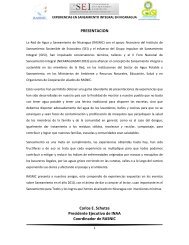Open Planning of Sanitation Systems
Open Planning of Sanitation Systems
Open Planning of Sanitation Systems
You also want an ePaper? Increase the reach of your titles
YUMPU automatically turns print PDFs into web optimized ePapers that Google loves.
Elisabeth Kvarnström and Ebba af PetersensIn areas where freshwater is scarce, the system may include reclamation <strong>of</strong> wastewater orgreywater. The reclaimed water can be used for domestic purposes, including yard irrigation,but should not be used as drinking water. However, the risk <strong>of</strong> soil salinization needs to beaddressed in climates with high evapotranspiration and low rainfall.CostsThe sanitary solution chosen should be economically reasonable with regards to capital as wellas recurrent costs. What “reasonable” entails varies much between countries and locales anddepends on the purchasing power <strong>of</strong> a community.A possible approach is to assume that the cost <strong>of</strong> a new system should not be significantlyhigher than the cost <strong>of</strong> systems generally used in a community. If subsidies or grants areavailable, then the actual investment cost may be <strong>of</strong> less importance.The user is normally responsible for operating the system and, therefore, also bears the cost<strong>of</strong> operation and sometimes also the maintenance. This cost could be in the form <strong>of</strong> in-kindwork only, i.e. no expenses are incurred, or it could include payment <strong>of</strong> contractors.ReliabilityInadequate system reliability will cause negative effects on users in terms <strong>of</strong> hygienic andenvironmental performance <strong>of</strong> the system and costs. The system should allow management<strong>of</strong> operational problems without negatively affecting people, property or the environment. Itis, however, best to avoid operational problems by selecting technologies that are robust andthat can cope with extreme weather conditions. Therefore, a basic function requirement is thatthe system is technically reliable. Additionally, the expertise to run and maintain equipmentshould be available locally.User aspectsThe sanitary installations (e.g. toilet, greywater) on the premises should fulfil basic userrequirements concerning affordability, user friendliness, maintenance, reliability, comfort,privacy, and status. It is also important to ensure realistic expectations <strong>of</strong> the system throughcapacity building and information. Irrespective <strong>of</strong> the technical solution chosen, it is essentialthat households use the system in an appropriate way. Water consumption and the typeand quantity <strong>of</strong> detergents are examples <strong>of</strong> factors that have a significant impact on systemperformance.Another aspect to consider is the experience <strong>of</strong> users with certain (including the current)institutional frameworks and their relationship with authorities. For example, different societiesand groups in a society will have different experiences with financial instruments, such astariffs or taxes. This in its turn will have an impact on which incentives will be effective. If theregulation enforcement is poor, which is <strong>of</strong>ten the case in many countries, it is important thatthe motivation to “do things the right way” comes from within the community.Further, the system should accommodate existing household habits and routines, ratherthan making the daily tasks more demanding or time-consuming. In fact, one <strong>of</strong> the greatestdriving forces for a new system seems to be the reduction <strong>of</strong> the time taken to complete dailytasks, and the resulting economic benefits (Drangert, 2004). It must be borne in mind, however,that when it comes to sanitation, gender aspects can play an important role concerning theallocation <strong>of</strong> daily tasks.10



![Project Document [PDF: 2.31 MB] - EcoSanRes](https://img.yumpu.com/51279385/1/184x260/project-document-pdf-231-mb-ecosanres.jpg?quality=85)












![Latrines à compost [high-resolution colour PDF: 12.3MB] - EcoSanRes](https://img.yumpu.com/31726141/1/185x260/latrines-a-compost-high-resolution-colour-pdf-123mb-ecosanres.jpg?quality=85)